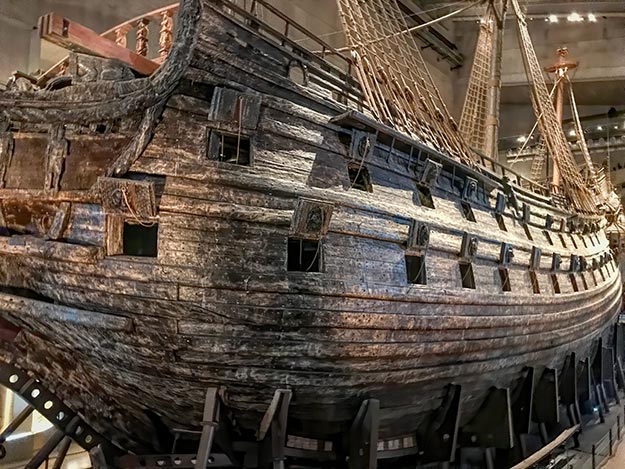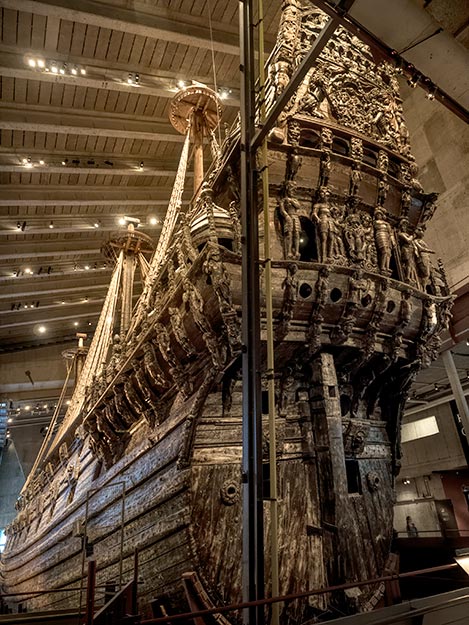In the 1620’s, intent on making Sweden a mighty military power, King Gustavus Adolphus began constructing a fleet of warships. The Vasa warship, first of the massive vessels to be completed, was the most powerful warship that had ever sailed the Baltic Sea. It measured more than 226-feet long and was 164-feet tall from the keel to the top of its main mast. It had ten sails, 64 cannons, and 132 tons of ballast. And it was staggeringly heavy. Even so, the King insisted that hundreds of hand-carved wooden sculptures be affixed to the hull to broadcast his power and majesty.

Concerned about the ship’s stability, the supervisor of construction notified the Vice Admiral of the Navy about his concerns. The Admiral ordered thirty men to run back and forth across the deck while the ship was tied up in front of the Royal Palace. The ship rolled so alarmingly that the Admiral stopped the demonstration, terrified that it would sink at the dock. Even so, no one dared question the King when he ordered it to set sail.

On August 10, 1628, Vasa cast off her mooring ropes, sailed about 1,400 yards, capsized, and sank to the bottom of the harbor. The ship’s masts, which protruded from the surface of the water, were cut off, and her valuable bronze cannons were salvaged. But the rest of the ship remained at the bottom of the sea. Over time, its existence was largely forgotten. In the 1950’s, an amateur archeologist and fuels engineer named Anders Franzén was researching old documents in Swedish archives when he read the story of the Vasa warship. Intrigued, he began dragging the bottom of Stockholm harbor. Before long, his coring equipment was bringing up plugs of black, waterlogged oak.

Divers soon confirmed that the wreck of the Vasa was sitting upright on the seafloor. It was astonishingly well-preserved. Not only is the water of the Baltic Sea too cold and fresh for shipworms, raw sewage that had been dumped into the harbor for centuries had created a dead zone at the bottom where even bacteria could not live. Efforts to raise the ship began in earnest in 1959 and took more than two years. On April 24, 1961, 333 years after sinking on her maiden voyage, Vasa finally emerged from her watery grave.
Thousands of spectators and press from around the world lined the shores to watch as the first timbers of the Vasa broke the surface of the water. Among them was my guide for the day, Ewa Ogren. Though she was just a child at the time, the raising of the Vasa made an indelible impression on her, and she was kind enough to share her memories with me in the following video.
Today the Vasa warship is on display at the Vasa Museum in Stockholm. I had missed seeing it on my first visit to Stockholm, so I was excited that my Spectacular Scandinavia tour with Collette included a visit to the museum, complete with a local guide. I walked through the front entrance and stopped in my tracks. The behemoth Vasa rose before me in all its glory. Double rows of wooden windows cut into the hull were propped open. Behind them would have lain heavy cannons, ready to do battle. Instead, water poured in through them as the ship rolled, sending her to the bottom within minutes.

Though some parts, such as its masts and rigging, have been reconstructed, most of the ship is original. Perhaps most impressive are the carvings, so beautiful, yet so deadly. Today we know that if the Vasa had been just a few inches wider, she would have been stable, despite the extra weight. But then we would never have the opportunity to see this magnificent example of a 17th century warship.
Intrigued and want to know more about the Vasa warship? Watch the video of the 1961 raising of the ship here.
Author’s note: I was a guest of Collette during my Spectacular Scandinavia tour. However, the receipt and acceptance of complimentary items or services will never influence the content, topics, or posts in this blog. I write the truth, the whole truth, and nothing but the truth.

We wre in Stockholm in 2013 or 2014. We walked around the VASA in the museum. It was a wonderful experience!
Hi Bert. I also found the place fascinating. The idea of a wooden ship surviving for so long underwater was quite mind boggling. And the story of the shipwreck’s discovery and raising is even more astounding, especially when told by a guide who witnessed it personally when she was a little girl.